Sensitivity Analysis for Antenna Using Monte-Carlo Simulation
This example shows a workflow for the sensitivity analysis of microstrip patch antenna gain using the design space sampling. You explore the design of a microstrip patch antenna to study the sensitivity with respect to different design parameters of the antenna. The design includes uncertainty for the patch and ground plane width. You explore the rectangular microstrip patch antenna design by characterizing design parameters using probability distributions. Generate the values of the patch width and ground plane width from random samples of the distribution functions and perform Monte-Carlo simulation of the design at each of the sample data points. You then visualize the design space to select the best design. Using the sampled design space, you perform Monte-Carlo evaluation and use the result to analyze the influence of design parameters on the design.
Specify Design Variables
Set the design frequency to 3 GHz with corresponding free-space wavelength lambda. Choose these properties as design variables:
GroundPlaneLength— Length of the ground planeLength— Length of the rectangular patch radiator
Set the initial values of the patch width and ground plane width as 0.25*lambda and 0.8*lambda, respectively. Limit the widths of the patch and the ground plane to within a range of 1.3 and 0.8 times of the initial values.
freq = 3e9;
lambda = 3e8/freq;
Np = 2;
pNames = {"GroundPlaneLength","Length"};
pInitVal = [0.8*lambda 0.25*lambda];
for m = 1:Np
p(m,1) = param.Continuous(pNames{m},eye(1));
p(m,1).Value = pInitVal(m);
p(m,1).Maximum = 1.3*pInitVal(m);
p(m,1).Minimum = 0.8*pInitVal(m);
endSample Design Space
Create a parameter space for the design variables using sdo.ParameterSpace (Simulink Design Optimization). The parameter space characterizes the allowable parameter values and combinations of parameter values.
pSpace = sdo.ParameterSpace(p);
The parameter space considers default uniform distributions for the design variables. Set lower and upper bounds of the distribution to the design variable minimum and maximum values, respectively. Use the sdo.sample (Simulink Design Optimization) function to generate samples from the parameter space. Use these samples to evaluate the model and explore the design space. Consider 10 sample points for the design space.
rng default;
nSamp=10;
pSmpl = sdo.sample(pSpace,nSamp);Use the sdo.scatterPlot (Simulink Design Optimization) function to visualize the sampled parameter space. The scatter plot shows parameter distributions on the diagonal subplots and pairwise parameter combinations on the off-diagonal subplots.
figure sdo.scatterPlot(pSmpl)
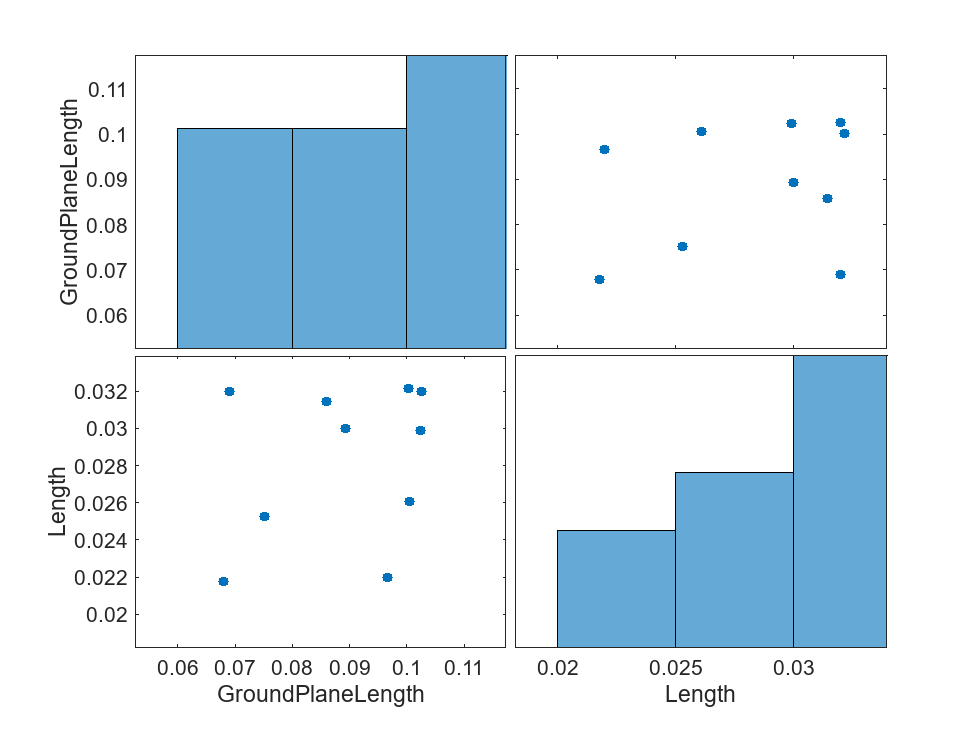
Specify Uncertain Variables
Select the patch and ground plane lengths as uncertain variables. Evaluate the design using different patch and ground plane lengths. Set initial values of the patch and ground plane lengths to 0.25*lambda and 0.5*lambda, respectively. Limit the variation of these lengths to within 1.3 and 0.8 times the initial values.
npUnc = 2;
pUncNames = {"GroundPlaneWidth","Width"};
pUncInitVal = [0.5*lambda 0.25*lambda];
for m = 1:npUnc
pUnc(m,1) = param.Continuous(pUncNames{m},eye(1));
pUnc(m,1).Value = pUncInitVal(m);
pUnc(m,1).Maximum = 1.5*pUncInitVal(m);
pUnc(m,1).Minimum = 0.9*pUncInitVal(m);
endCreate a parameter space for the uncertain variables. Use normal distributions for both variables. Specify the mean as the current parameter value. Specify a variance of 5% of the mean for the GroundPlaneLength and 3% of the mean for the Length.
pUncDistributionType = {"normal","normal"};
pUncDistributionMean = [0.05 0.03];
uSpace = sdo.ParameterSpace(pUnc);
for m = 1:npUnc
uSpace = setDistribution(uSpace,pUncNames{m},makedist(pUncDistributionType{m}, ...
pUnc(m,1).Value,pUncDistributionMean(m)*pUnc(m,1).Value));
endYou can modify this information in the parameter space. This example considers an ideal correlation matrix.
uSpace.RankCorrelation = [1 0; 0 1];
The rank correlation matrix has a row and column for each parameter. The entry in the row and column gives the correlation between parameters and . Sample the parameter space. The scatter plot shows the correlation between the patch and ground plane length.
nSampUnc = 10; uSmpl = sdo.sample(uSpace,nSampUnc); figure sdo.scatterPlot(uSmpl)
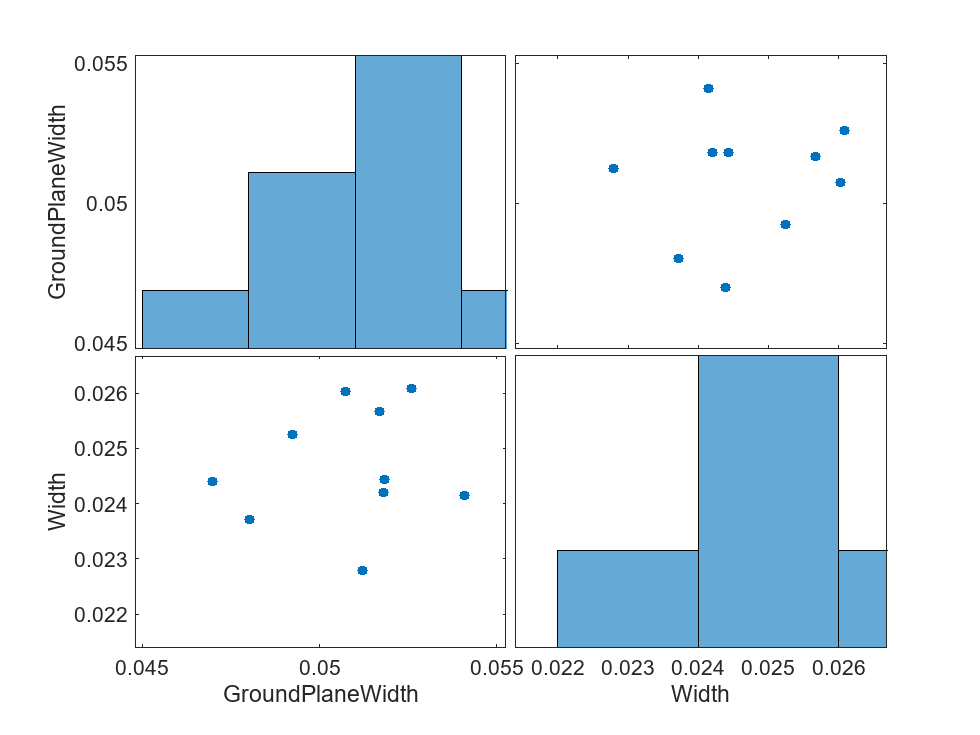
Ideally, you want to evaluate the design for every combination of points in the design and uncertain spaces, which implies (nSamp)*(nSampUnc) simulations. You can use parallel computing to speed up the evaluation.
Create Initial Antenna and Visualize the Geometry
Create a microstrip patch antenna using the design function at 3 GHz. Set the patch and ground plane dimensions to their initial values and visualize the antenna.
ant = design(patchMicrostrip,freq); ant.GroundPlaneLength = pInitVal(1); ant.Length = pInitVal(2); ant.GroundPlaneWidth = pUncInitVal(1); ant.Width = pUncInitVal(2); ant.Height = 0.8*1e-3; ant.FeedOffset = [0.005 0]; figure show(ant)
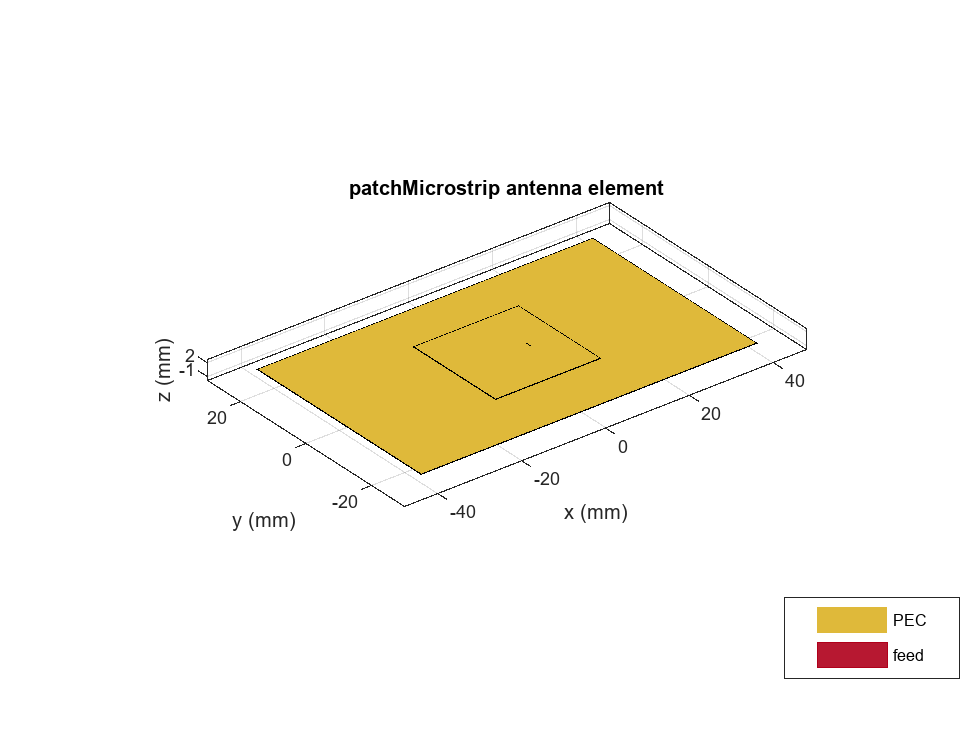
Specify Design Requirements
Evaluating a point in the design space requires specifying the expected threshold value. Here, you analyze the gain of the antenna. Compute the reference gain of the antenna using pattern with a logarithmic scale. Convert the gain value to a linear scale. Specify the number of iterations for the Monte-Carlo simulation. To reduce the simulation time, set the number of iterations to 10. Specify a higher value of numIterations for more accurate results.
gRef = max(max(pattern(ant,freq,Type="gain")));
linGain = 10^(0.1*gRef);
numIterations = 10;Evaluate Antenna Design
Use iterative calls to construct the antenna for different property values and compute the gain. Check whether the computed gain meets the expected gain threshold to compute the cost function for the Monte-Carlo simulation.
probGain = zeros(size(pSmpl,1),1); pSmpl_mat = table2array(pSmpl); uSmpl_mat = table2array(uSmpl); for i = 1:size(pSmpl_mat,1) ant.GroundPlaneLength = pSmpl_mat(i,1); ant.Length = pSmpl_mat(i,2); costGain = 0; for index = 1:numIterations for ct = 1:size(uSmpl_mat,1) ant.GroundPlaneWidth = uSmpl_mat(ct,1); ant.Width = uSmpl_mat(ct,2); gainVal = max(max(pattern(ant,freq))); gainVal = 10^(0.1*gainVal); if gainVal>linGain costGain = costGain + 1; end end end probGain(i,1) = costGain/(numIterations*size(uSmpl_mat,1)); end
View the results of the evaluation using a scatter plot. The scatter plot shows pairwise plots for each design variable and design cost. The plot shows that larger cross-sectional areas result in lower total costs.
y = table(probGain); figure sdo.scatterPlot(pSmpl,y)
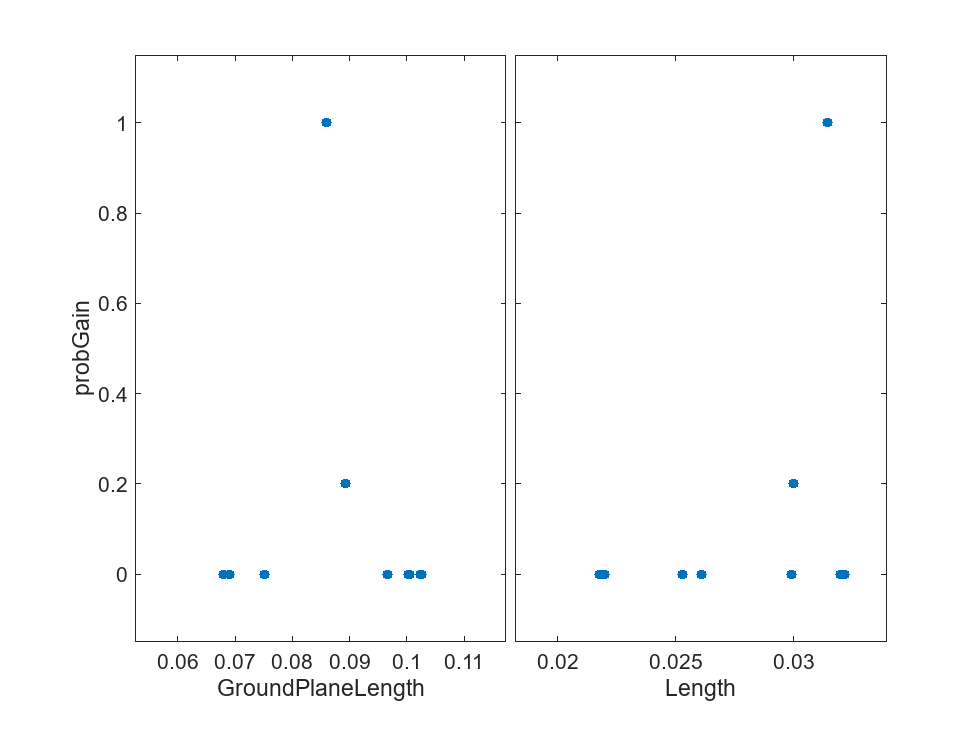
Create a mesh plot showing the total cost as a function of GroundPlaneLength and Length.
fTotal = scatteredInterpolant(pSmpl.GroundPlaneLength,... pSmpl.Length,y.probGain); xR = linspace(min(pSmpl.GroundPlaneLength),max(pSmpl.GroundPlaneLength),60); yR = linspace(min(pSmpl.Length),max(pSmpl.Length),60); [xx,yy] = meshgrid(xR,yR); zz = fTotal(xx,yy); figure mesh(xx,yy,zz) view(56,30) title("Total Cost as Function of GroundPlaneLength and Length") zlabel("prob_{gain}"); xlabel(p(1).Name); ylabel(p(2).Name);
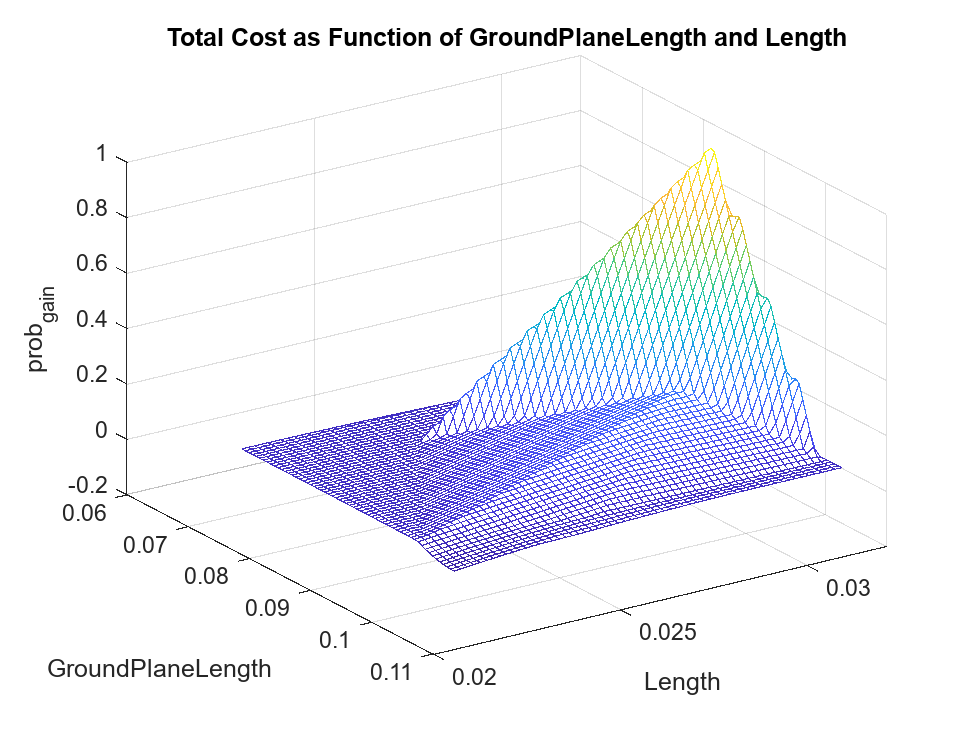
Further Exploration
You can further investigate the design variables of the antenna or array to perform sensitivity analysis on different output parameters like input impedance, gain, and efficiency. For an antenna or array configuration containing a large number of design variables, you can use this design space exploration approach to determine the most sensitive design parameters.
See Also
Functions
design|pattern|sdo.sample(Simulink Design Optimization) |sdo.scatterPlot(Simulink Design Optimization)
Classes
sdo.ParameterSpace(Simulink Design Optimization)